Magnum MSH3012 Hybrid Inverter
Upgrading a Motorhome's Electrical System With the Latest Technology From Magnum Energy
Article Date: August, 2013
Article by Mark Quasius
Photography by Mark and Leann Quasius
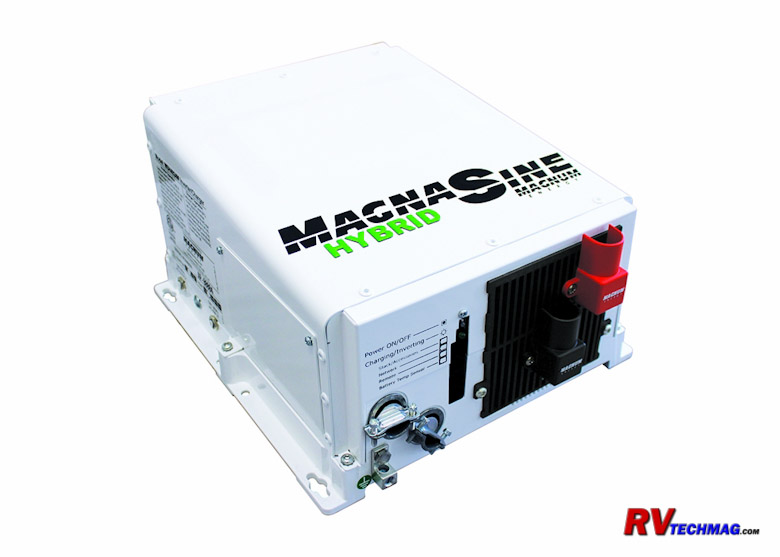
An inverter is a great accessory for any motorhome. Shore power provides plenty of power when your RV is plugged
into a campground pedestal, but isn't available when driving or dry camping. You can always run the generator, but that isn't always the
most cost-effective thing to do just to watch a movie or fire up the microwave oven. An inverter will take 12-volt battery power and
transform it to 120-volt alternating current (AC) power. It's the perfect solution for times when you just don't want to fire up the
generator. They are silent, which means they're not subject to campground quiet times, and do not burn up precious fuel.
The Basics
All circuits to be powered by the inverter are placed into a circuit breaker sub-panel connected to the inverter's
AC output. The main circuit breaker panel also supplies 120-volt power to the inverter's AC input terminals. Whenever shore power is
available or the generator is running, AC current will be present at the inverter's input. This AC power is used to operate the inverter's
battery charging mode, so the batteries can be recharged, and is also passed through to the inverter's output terminals via an internal
transfer switch. Whenever 120-volt power is not present at the inverter's AC input terminals, the transfer switch switches over to use
12-volt battery power to create 120-volt AC power. The transfer switch operates in an either/or mode. The inverter's 120-volt AC output is
either connected to the incoming AC power in pass-through mode or to the inverter's internal circuitry to supply 120-volt AC output via
inversion from the 12-volt battery bank.
A 50-amp campground pedestal provides plenty of power and meets most RV's electrical needs. When plugged into a 20
or 30-amp pedestal, the available power may not be enough to operate all accessories. Load-shedding energy-management systems, such as
those made by Intellitec or Precision Circuits, can shut down certain circuits to prevent overloading the system and tripping the
campground pedestal breaker. The system accomplishes this by temporarily shutting down high-amperage circuits, such as air
conditioners or refrigerators.
Introducing The Magnum Hybrid
Magnum Energy has been making inverters, automatic generator start systems, and other electrical components for a
long time and is a popular choice with many RV manufacturers. The company is respected for producing quality, innovative products made in
the USA and offers excellent support. Magnum's latest innovation is a new ground-breaking hybrid inverter/charger. The MSH3012M is a
3,000-watt true sine wave inverter/charger, but what really separates this unit from the rest is its hybrid technology. Typical inverters
use only one source of energy to power the inverter's output loads. The transfer switch selects either the incoming AC power from a generator
or shore power or it selects power created by the inverter. The MSH3012M has the unique ability to combine the incoming shore or generator
AC power with the inverter-created power to deliver more power to the coach's AC loads than the generator or shore circuit can provide.
When in load-support mode the inverter is capable of providing up to 60 amps of power to the accessories.
The Magnum Hybrid inverter/charger can also be combined with an Automatic Generator Start system and a Power Control
System, (a load-shedding energy-management system) made by Precision Circuits, Inc. Data communication between these components provides
a truly comprehensive energy-management system that will automatically handle your coach's electrical needs.
|
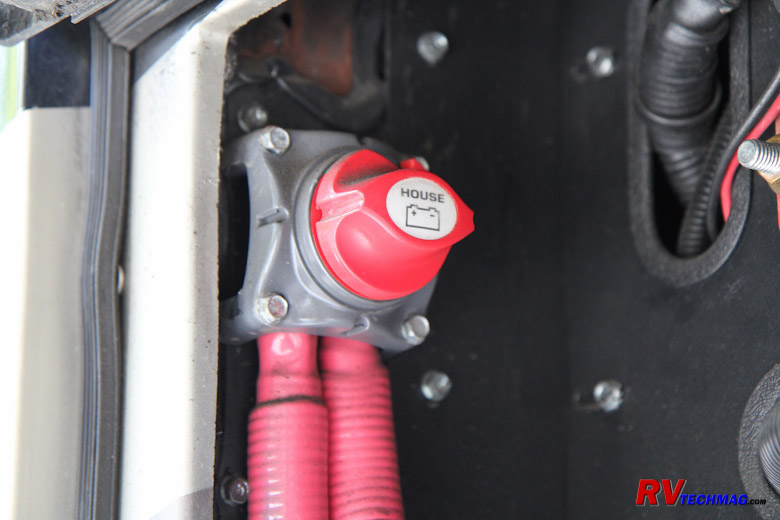
Before any work was performed, all power to the RV was disconnected at the breaker panel and battery disconnect switch.
|
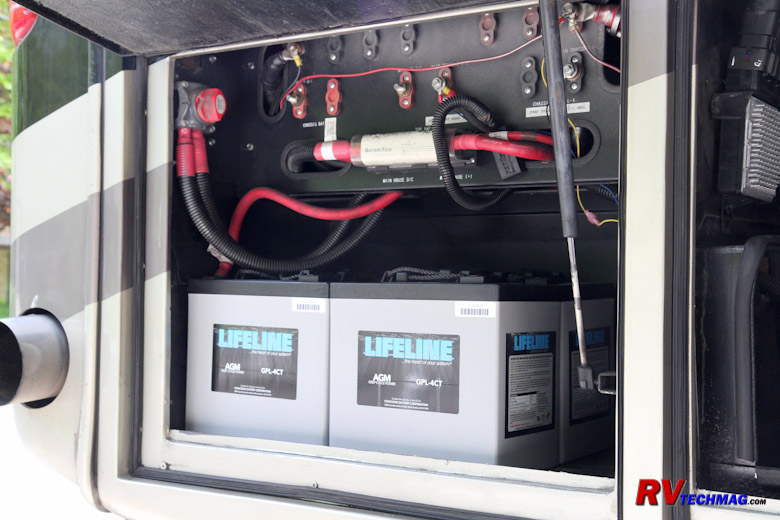
The new Lifeline 6-volt AGM batteries were fatter than the original 12-volt batteries but were also shorter, making it
possible to arrange them in an end-to-end and side-to-side pattern.
|
|
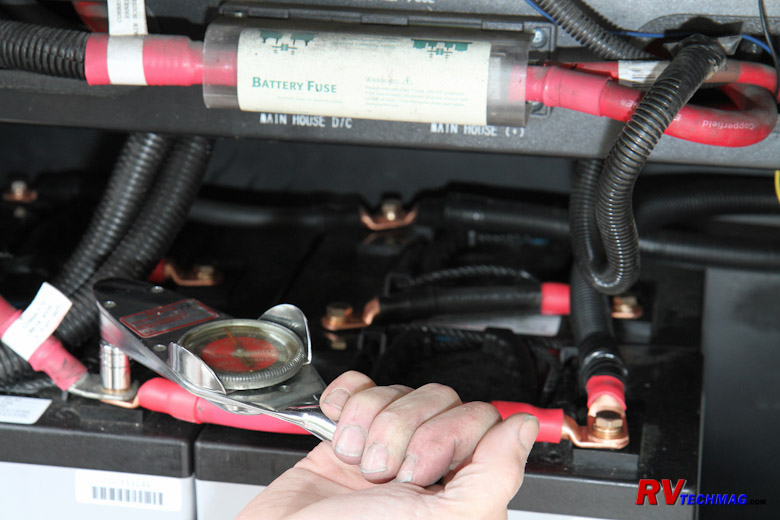
The battery cables were attached with the supplied brass bolts and torqued to the recommended 170-inch pounds.
|

The original inverter was located in a basement compartment in an area that interfered with cargo space. The existing
inverter was removed, and its mounting frame cut out of the RV.
|
Installation
My coach had a number of issues that needed to be corrected and improved. It was originally equipped with eight
12-volt batteries. These were AGM batteries but were designed for mobility applications. They were only rated at 88 amp-hrs, which gave
me a total battery bank capacity of 704 amp-hrs. They were now 6 years old and were going to need to be replaced soon anyway, so I decided
to upgrade the batteries to Lifeline 6-volt AGM batteries, considered by many to be the best available. Each battery was rated at
220 amp-hrs. By arranging them in a series-parallel configuration, I would have a total capacity of 880 amp-hrs.
My coach originally came with a 3,000-watt modified sine wave inverter and no energy-management system. The inverter
was beginning to show its age, so it was the perfect time to upgrade to the Magnum Hybrid inverter. I also added a 12-volt disconnect
switch and 400-amp fuse because these were not installed when my motorhome was initially built. The Magnum battery temperature sensor was
connected to the negative battery post, and my existing inverter's remote-control panel was replaced with the new Magnum control panel.
I also installed the Power Control System energy-management system by Precision Circuits to take full advantage of the
benefits of the new inverter. This required replacing the original breaker panel with a similarly sized unit that incorporated the load-shedding
relays and control circuit board. A cat5 communications cable connected the PCS-equipped breaker panel to an informative remote display panel
that showed all of the voltage and current usage parameters as well as the status of any circuits being shed. A second communications cable ran
to the Magnum inverter.
The Magnum remote-control panel is also capable of controlling an automatic generator start system, but my coach was
equipped with an Onan EC-30 stand-alone system, which I left in place. I did add Magnum's Battery Monitor Kit, which uses a shunt in the
negative battery cable to communicate to a module that displays additional information on the inverter control panel. The BMK provides
detailed information on battery usage and state of charge and is a great tool for keeping track of your batteries and 12-volt system usage.
|
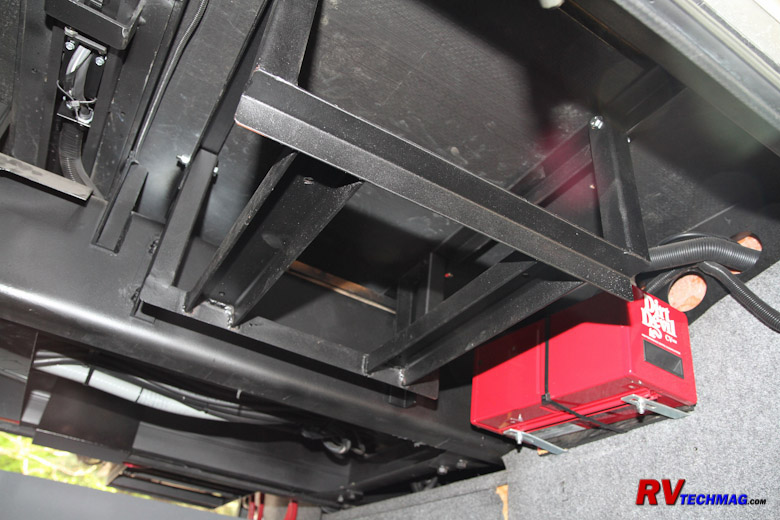
A new mounting cradle was fabricated on the opposite side of the RV, designed not to extend beneath the frame rails and
allow for smooth cargo access.
|
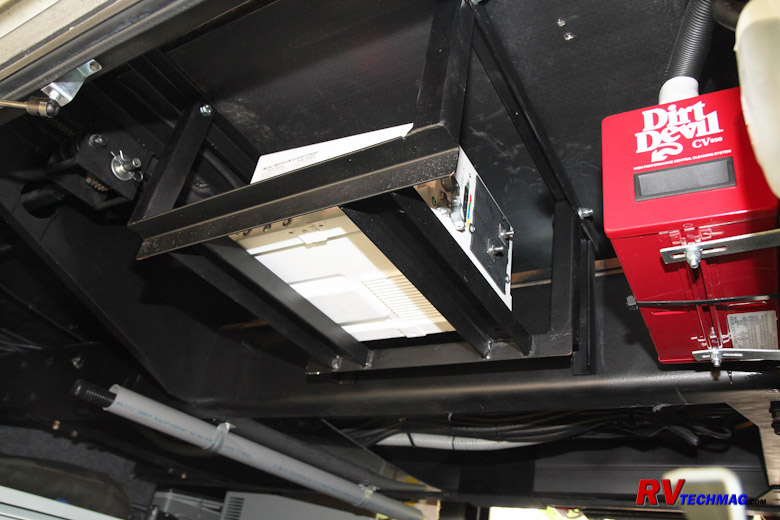
The inverter fit perfectly into the new cradle, although it was a handful to lift into place.
|
|
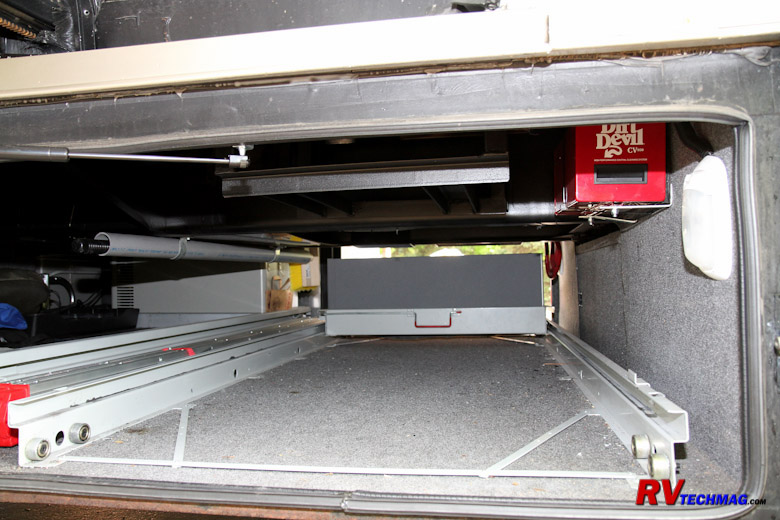
With the inverter installed there was plenty of room for cargo storage on the sliding cargo tray.
|

Battery cables were made from #2/0 cable. Terminal ends were crimped using a heavy-duty crimp tool. Soldered
connections are not recommended; the solder can melt under heavy current loads and cause the connection to fail.
|
Operation
After everything was installed, I powered up the new system. The PCS energy-management system immediately booted up
and displayed the voltage and current draw on each leg. The Magnum inverter's remote-control panel was fitted with a handy rotary knob with
push-to-set function, which made it easy to scroll through and select the various setup parameters. I set the various battery monitor and
charge parameters, and the entire system was operational.
The inverter immediately entered battery-charge mode. The batteries were fairly well charged, so it didn't take long
for the charge to taper off and enter float mode. The battery monitor monitors all power going into or coming out of the batteries and uses
software calculations to display a true state of charge in a percentage that compensates for battery type, size, and temperature.
Once disconnected from the shore power, the inverter switched over to inverter mode. I then switched over to a smaller
20-amp shore power feed and set the incoming power down to 15 amps on the remote-control panel. The Magnum hybrid inverter automatically
reduced the battery charging rate so there was still adequate power to run the coach's accessories. I loaded up the system to draw close to
15 amps, then fired up the microwave to test the load support capability of the hybrid inverter. The inverter seamlessly added the additional
power required to operate the microwave without tripping the pedestal breaker.
When connected to a 30-amp service, which is equivalent to 3,600 watts, I ran two air conditioners and a few other
items to bring the total load close to 30 amps. I then switched on the microwave, and the inverter once again went into load-support mode
and provided the additional boost in power required. I next switched on the electric heating element of the Aqua Hot boiler, a circuit
that is not fed by the inverter. The PCS energy-management system determined that this would exceed the 30 amps of available shore power and
it shed one of the air-conditioner circuits to prevent tripping the pedestal breaker. Once the heating element was switched off, the
energy management system restored power to the second air conditioner. Any circuits connected to the inverter would benefit from the
inverter's load-support mode, making total available power in excess of 6,000 watts.
The combination of Magnum's hybrid inverter, an automatic generator start module, and the Precision Circuits
energy-management system creates a system-wide energy-management system. This load assist also makes it possible for manufacturers to
build motorhomes with smaller generators, which results in less weight and improved fuel economy. This inverter is bound to be very
popular in the near future.
|
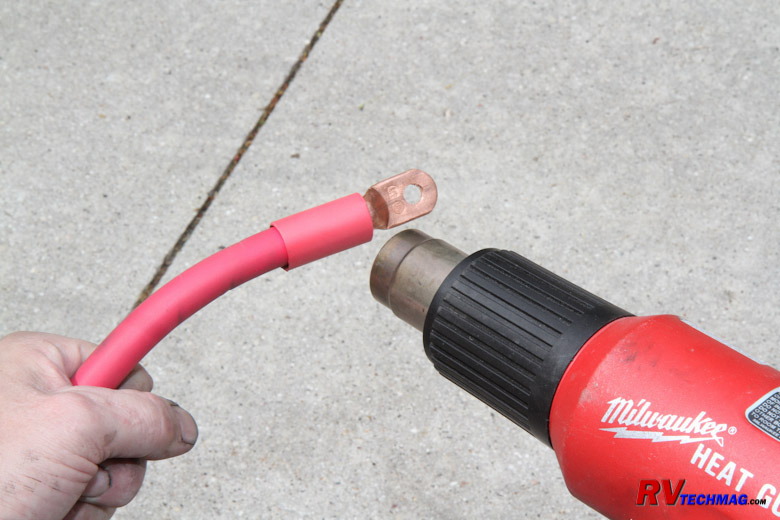
To prevent corrosion and provide a nice weathertight seal, adhesive-lined shrink tube was applied over each terminal connection.
|
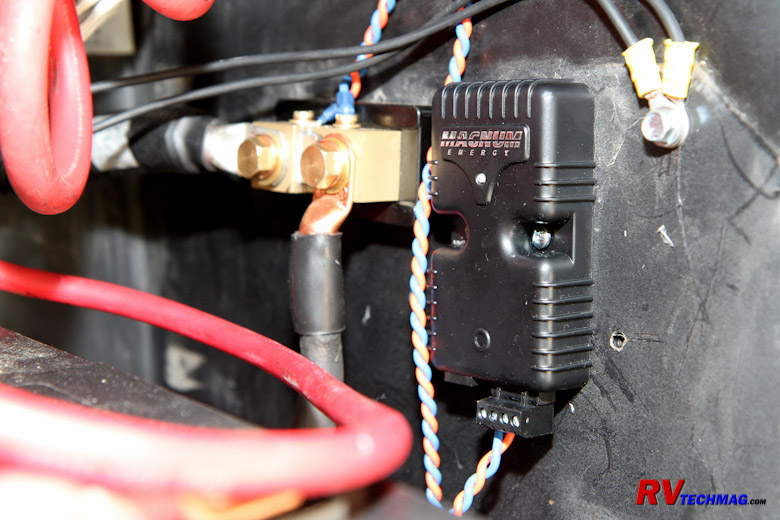
The Battery Monitor Kit module was installed in one of the battery compartments. Low-voltage wires provided 12-volt power and
ground, as well as a connection to the DC shunt in the negative battery cable. A network cable was used to communicate with
the Magnum inverter.
|
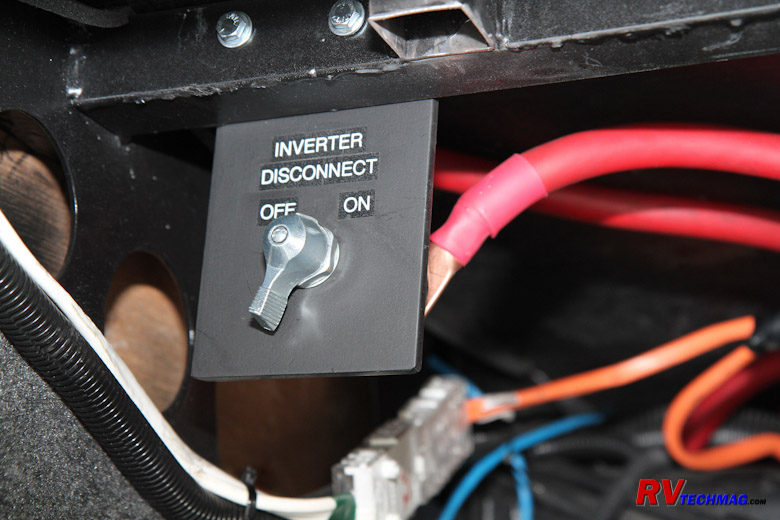
A 12-volt disconnect switch was added to the inverter to disconnect power to the inverter during storage or when servicing the unit.
|
|
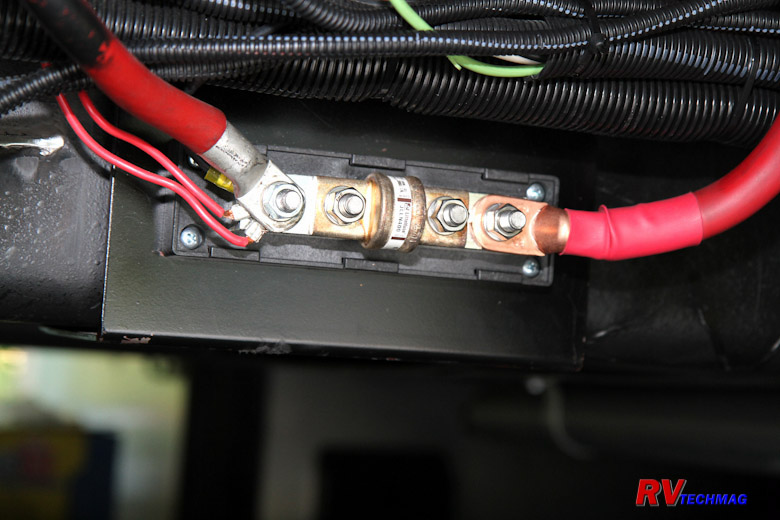
A 400-amp fuse was inserted into the inverter's positive battery cable to provide overcurrent protection to the inverter.
|

Magnum's remote control panel provided easy access to both the inverter and battery monitor information. The multi-function knob made
it easy to scan parameters and enter any setup changes.
|
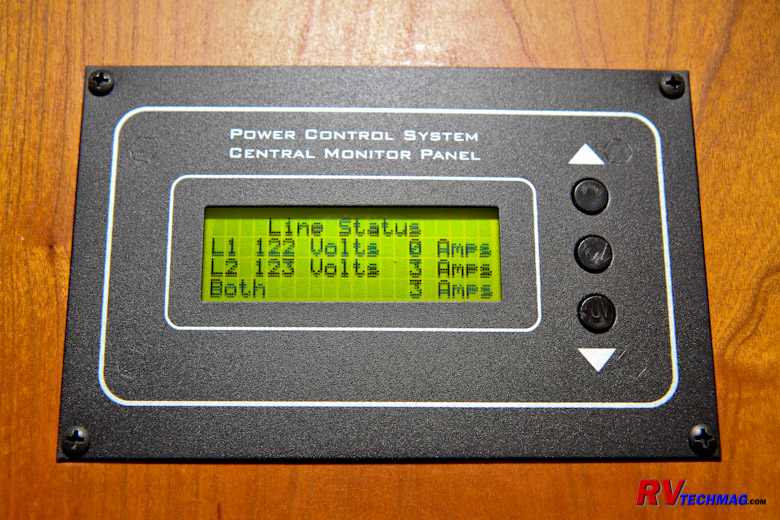
The Precision Circuits energy management system also included an informative remote panel that displayed information pertaining
to the 120-volt electrical system.
|
Source
Magnum Energy
(425) 353-8833
www.magnumenergy.com
Precision Circuits, Inc
(630) 515-9100
www.precisioncircuitsinc.com
Lifeline Batteries
(909) 599-7816
www.lifelinebatteries.com
Return to Home Page
If you enjoyed this article be sure to recommend RVtechMag.com to your friends, like us on Facebook or Twitter
or subscribe to our RSS feed.



|



















